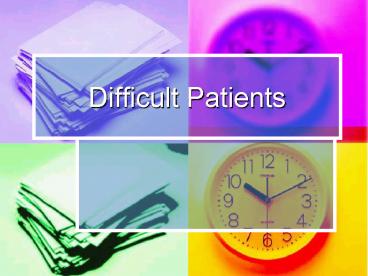Difficult Patients - PowerPoint PPT Presentation
1 / 17
Title:
Difficult Patients
Description:
... Patients 'Difficult' Patients. Complain. Unclean. Uncooperative. Extremely demanding ... Socially unacceptable illnesses (STD, addictive disorders) The ' ... – PowerPoint PPT presentation
Number of Views:989
Avg rating:3.0/5.0
Title: Difficult Patients
1
Difficult Patients
2
Difficult Patients
- Complain
- Unclean
- Uncooperative
- Extremely demanding
- Want to be waited on
- Socially unacceptable illnesses (STD, addictive
disorders)
3
The Difficult Patient
- Disruptive
- Self-destructive
- Sexually harassing
- Aggressive or Violent
4
Factors that Lead to a Rise in Aggression
- Frustration
- Involuntary referral
- Discontent with treatment
- Pathology
- Schizophrenia w/ personality disorder
- Mania
- Environment
- Space
- Crowding
- Staff-patient ratios
5
Behavioral Phases of Violence
- Baseline or relative calm
- Pre-assault
- Abusive remarks or physical agitation
- Assault
- Out of control physical and verbal behavior
implement crisis intervention protocol
6
Warning Signs
- Rapid, loud or profane speech
- Change in level of consciousness (e.g.
disorientation or confusion) - Clenched fists, gritting teeth, reddening face,
widened eyes, flaring nostrils, rapid breathing - Motor agitation pacing
7
More Warning Signs
- Visual or auditory hallucinations
- Sudden change in or extremes of affect (e.g.
exhilaration, grandiosity) - Sudden lack of affect in a previously very
agitated or threatening person - Use of alcohol or drugs
8
Management of Violence in the Workplace
- Prevention
- Treating patients and their families with respect
- Institutional security measures
- De-escalation Techniques
9
Prevention
- Dont use negative or derogatory labels.
- Try to change climate that devalues patient.
- Seek support and advice for dealing with
difficult patients. - Be aware of your emotional responses to patients.
- Affirm policies and practices that encourage
respect.
10
Treating Patients with Respect
- Are patients and relatives given sufficient
information to avoid feeling helpless? - Could the environment be made more comfortable
(e.g. waiting areas)? - Do patients know how and to whom to complain?
11
Institutional Security Measures
- Make sure that areas are secure from people from
the outside wandering around. - Monitor areas that are isolated at specific times
of the day or night. - Keep walkways lit and free from hazards no
blind corners. - Provide a way for staff to raise an alarm to call
for help, e.g. panic buttons, intercoms, cell
phones. - Train staff on what to do in a violent situation.
12
More Institutional Methods
- Arrange furniture and equipment so that staff
wont be trapped. - Make sure treatment rooms have two exits.
13
De-escalation Techniques
- First Make sure you have an escape route.
- Stay in an open, populated area
- Dont let the patient get between you and the
door. - Never turn your back on the patient.
- Dont crowd the patients personal space or try
to touch him. - Keep your own emotions under control and remember
to breathe.
14
More De-escalation
- Dont try to talk while the patient is shouting.
- Do not
- Challenge or become defensive or confrontational
- Insult the patient
- Become judgmental or deny what is happening
15
More De-escalation
- Be genuine in your attempts to listen and affirm
the persons feelings - Let him express grievances, but respond
selectively - Speak in a normal tone of voice
- Communicate in simple sentences
- Show your concern
- Clear up misconceptions
- Acknowledge valid complaints
- Dont react to abusive statements
- Offer realistic solutions if appropriate.
16
More De-escalation
- Set limits calmly but firmly
- Call for back-up or security before the patients
behavior escalates to violence - Report all near-violent episodes dont blame
yourself and try to hide it - Broken windows theory tolerating lesser
incidents results in increasingly violent
behavior
17
Role-PlayingDifficult Cases































